Discoveries for life
The faces of health research 2022
| Title |
|---|
Exploring the 'osteo' in osteoarthritisEarly detection of osteoarthritis may start with changes within bone 
Osteoarthritis (OA) is the most common chronic joint disease. OA can be accelerated by joint injury and is truly a disease that can affect individuals throughout their lives, causing significant pain and loss of function. The ability to detect OA-related joint changes early remains a problem. This limits treatment options before changes become permanent. Recent research has indicated that OA is not simply a 'wear and tear' joint disease but an inability of the body to repair damaged tissues. There are inter-relationships between all joint tissues and recent research has shown that changes to, or within, bone may occur before damage to other joint tissues can be detected. As part of his CIHR Banting Postdoctoral Fellowship, Dr. Nikolas Knowles explored bone changes following an acute injury to the anterior cruciate ligament of the knee in a longitudinal cohort using multi-modality imaging. This high-resolution imaging revealed irreversible changes to bone microstructure within four years, post injury, as well as important changes to the bone's marrow tissues. Now as an Assistant Professor in the Department of Kinesiology and Health Sciences at the University of Waterloo, Dr. Knowles is building on these findings and aims to develop an imaging-experimental-computational framework to further understand the mechanistic pathways to OA initiation, progression, and treatment. Related reading:
|
Transforming trials into a worldwide impactNephrologist develops promising solutions through innovative partnerships 
Dr. Garg’s research is focused on improving health outcomes of patients who suffer from kidney disease by examining their cases from early diagnosis right through to treatment. To achieve this, he has developed streamlined, innovative approaches to clinical trials and examined big data resources. He recently focused on improving living kidney donor evaluation and conducted MyTEMP, a large-scale pragmatic trial that focused on determining whether dialysate fluid temperature changes can reduce cardiovascular-related hospital admission or death. Dr. Garg continues to conduct his own research in nephrology and train new researchers in innovative trial methods. He also worked with a team of stakeholders to create the Accelerating Randomized Trials (ART) Platform to help researchers conduct efficient, large-scale pragmatic trials, prioritizing simple, scalable, and sustainable interventions. Related reading:
Recent publications:
|


SodiUm Glucose co-trAnspoRt-2 inhibitioN diabeteS and kidney function Loss in Type 1 diabetes: The "SUGARNSALT" Team Grant ProgramDr. David Cherney Dr. David Cherney is a Professor of Medicine and Clinician-Scientist in the Division of Nephrology at the University of Toronto. He is also a physician at the University Health Network and Mount Sinai Hospitals, where he is the director of the Renal Physiology Laboratory. With a specific interest in the relationship between diabetes and kidney and heart disease, Dr. Cherney’s research focuses on the physiological factors that lead to kidney disease in patients with diabetes. He has led a number of large clinical trials that look at the different causes of kidney disease, particularly diabetes. Dr. Cherney is the Nominated Principal Investigator for a CIHR Diabetes Mechanisms and Translational Solutions Team Grant. In his research program, they will study kidney effects of SGLT2 inhibition in people with type 1 diabetes over a two-year treatment period, including blood and urine tests; seek to understand how these medications work over the long term; examine ways to avoid side effects; and check to see how patients feel about taking these medications, in terms of both benefits and side effects. Next, they will use Danish health records (where SGLT2 inhibitors can be used for type 1 diabetes) to determine if these therapies reduce the risk of kidney disease when used as part of routine care for type 1 diabetes. Finally, they will study the effectiveness of these medications as a long-term kidney protective therapy using mathematical models. Overall, this program has the potential to reduce the risk of diabetes complications and improve the quality of life in people living with this serious condition. Further reading
|
Precision medicine study of type 2 diabetes in the COLCOT-T2D trial

Marie-Pierre Dubé is a professor at Université de Montréal and she is the director of the Beaulieu-Saucier Pharmacogenomics Centre at the Montreal Heart Institute. She holds the Canada Research Chair in Precision Medicine Data Analysis. Her research is focused on genomic studies of clinical trials in cardiovascular and metabolic diseases and on the impact of sex, gender and genetics on the efficacy and safety of medication. Dr. Dubé is the Nominated Principal Investigator for a CIHR Diabetes Mechanisms and Translational Solutions Team Grant. Her team will study the biological pathways involved in the response to medication used to treat diabetes. In the COLCOT-T2D trial, the anti-inflammatory medication colchicine is being assessed for its ability to reduce major cardiovascular events in 10,000 patients living with type 2 diabetes. Her team will collect DNA and blood samples and use the techniques of genomics (to measure DNA variation) and proteomics (variation in protein levels), and they will measure drug metabolites in circulation in the blood of patients. The study will allow them to determine which patients may benefit more or less from colchicine and from other medication used to treat diabetes. They will also study the role of both sex and gender on disease progression, drug response and on study participation. Her Team Grant will provide valuable evidence toward better prevention strategies and treatment options for patients living with type 2 diabetes. Further reading
|
Central role of muscle autophagy in metabolism and musculoskeletal health
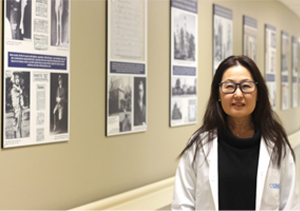
Minna Woo, MD, PhD, is the Ajmera Family Chair in Molecular Diabetes Research and Canada Research Chair in Signal Transduction in Diabetes Pathogenesis. She is a Professor in the Department of Medicine at the University of Toronto and a Senior Scientist and Metabolism Group Lead at the Toronto General Hospital Research Institute, University Health Network. She also serves as the Division Chief for Endocrinology and Metabolism at the University Health Network and Sinai Health System. Her research focuses on elucidating the molecular mechanisms that determine pathogenesis of insulin resistance and type 2 diabetes (T2D). She studies the role of insulin resistance in cancer and cardiovascular diseases. Dr. Woo is the Nominated Principal Investigator for a CIHR Diabetes Mechanisms and Translational Solutions Team Grant. Type 2 diabetes (T2D) and osteoarthritis (OA) often occur together, and both are associated with a condition called sarcopenia. Sarcopenia refers to the loss of muscle mass and strength that occurs with aging. Dr. Woo’s team posits that sarcopenia serves as a common link between T2D and OA. Autophagy is a 'self-eating' process that eliminates damaged components of cells. When autophagy is defective in muscle, damaged cell components can accumulate, and this can lead to sarcopenia. The purpose of her team grant is to determine how problems with muscle autophagy contribute to T2D and OA. To accomplish this objective, her team will study mouse models in which genes regulating autophagy have been altered in muscle and examine for OA in these mice. They will also assess if they can treat or reverse T2D and OA using gene therapy to restore autophagy in muscle. Finally, they will take samples of muscle, blood, as well as knee imaging from human subjects with these conditions and analyze them to identify common genetic links between T2D and OA to identify new drug targets. Further reading
|
A deep phenotyping network for understanding human islet variation in health and diabetes

Dr. Patrick MacDonald holds a Canada Research Chair in Islet Biology and is a Professor of Pharmacology at the University of Alberta. His main interests lie in understanding the mechanisms that control hormone release from the endocrine pancreatic islets of Langerhans, and how this is disrupted in diabetes. Insulin is the primary hormone responsible for controlling blood sugar levels. It is produced by the pancreatic islets of Langerhans, rises after a meal to promote energy storage, and falls during fasting to allow energy mobilization. The levels of insulin in the blood vary tremendously among people. Nutrition, age, sex, genetics, and environmental exposures are all important factors likely to impact insulin levels. However, the underlying mechanisms by which these factors affect islet insulin production at the cellular level are not clear. Dr. MacDonald is the Nominated Principal Investigator for a CIHR Diabetes Mechanisms and Translational Solutions Team Grant. His team seeks to understand the variability in human islet function in relation to genetic and environmental impacts on diabetes risk and to identify mechanisms of islet dysfunction in diabetes. To do this they will take advantage of extensive data on the molecular, cellular, and physiological function of islets from human organ donors. They will also produce tools and resources so that other researchers can explore this data to answer their own questions about islet dysfunction in diabetes. Further reading
|
Precise treatment for pediatric diabetes: Providing the right care, for the right patient, at the right time, over time

Dr. Shazhan Amed, MD, MSc, is a Clinical Professor in the Department of Pediatrics, Division of Endocrinology at the University of British Columbia. She is also a pediatric endocrinologist at BC Children’s Hospital in Vancouver. In addition to treating children and youth with diabetes and other endocrine disorders, Dr. Amed is a health services and population health researcher. Her research is focused on the prevention of childhood obesity and youth-onset type 2 diabetes, population-level surveillance of childhood type 1 and type 2 diabetes, quality improvement, and digital health. Dr. Amed is the Nominated Principal Investigator for a CIHR Diabetes Mechanisms and Translational Solutions Team Grant. Her team will develop strategies to address research gaps related to youth with diabetes who continue to have a higher risk of other health problems, a lower quality of life, and a shorter life span than their peers without diabetes. The Canadian pediatric diabetes consortium (CAPACIty) is a network of 15 childhood diabetes centers from across Canada who are partnering with patients/families and health care professionals to jointly design and develop a Canada-wide childhood diabetes registry and research platform. The registry will enable them to improve diabetes care and health outcomes for Canadian youth through comparison of diabetes care quality and outcomes between Canadian diabetes centers, quality improvement initiatives, patient-informed research initiatives across Canada, and successful advocacy work. In 2023, Dr. Amed was a recipient of the CIHR-JDRF Type 1 Diabetes and Precision Medicine team grant. Her team aims to expand the capabilities of a new digital tool, TrustSphere, that was developed by the BC Children’s Hospital (BCCH) Diabetes Clinic to solve the problem of health information and data in different places. This tool allows patients and families, and their healthcare providers to see important diabetes information or recommendations from the diabetes team in one place. By collecting more data from patients such as their healthy living behaviors, diabetes self-management behaviors, quality of life and mental health, and combine this data with glucose sensor and pump data, her team will co-create personalized and tailored care experiences. Their goal is to create a collaborative care experience, improve diabetes self-management, and ultimately improve patient experience and outcomes. Further reading
|

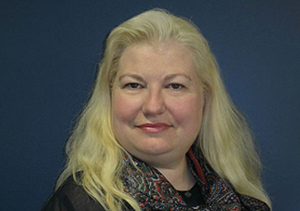
Preventing vision loss from diabetic retinopathy: Guiding primary care diabetic retinopathy screening in Canada through the use of provincial healthcare administrative dataDr. Valeria Rac Valeria Rac, MD, PhD, is an Associate Professor at the Institute of Health Policy, Management and Evaluation, University of Toronto. She is also a Scientist with the Peter Munk Cardiac Centre and Ted Rogers Centre for Heart Research, Toronto General Hospital Research Institute and Director of the Program for Health System and Technology Evaluation. Dr. Rac is a Co-Lead of the Diabetic Retinopathy Screening Program and Knowledge Mobilization, Implementation and Evaluation Program with the CIHR SPOR Diabetes Action Canada Network. Dr. Rac is the Nominated Principal Investigator for a CIHR Diabetes Mechanisms and Translational Solutions Team Grant. Her team proposes to support primary healthcare diabetic retinopathy (DR) screening by using provincial administrative data in Ontario, Alberta, British Columbia and Newfoundland and Labrador to determine who needs to have their eyes examined according to clinical practice guidelines. The generated lists of individuals will be provided to a community care setting to arrange eye appointments. Coordination and capacity of care within the participating provinces will also be examined. Various research methods will be used to evaluate the effectiveness, cost-effectiveness, implementation issues and barriers, and sex- and gender-related differences in the provision of care and keys to success. The broader goal of this public health initiative is to identify unmet care needs, and to begin the pathway towards the creation of a Canadian DR screening program, similar to that in the United Kingdom, and consequently eliminate DR as the leading cause of blindness in working-age individuals. Further reading
|
Designing stem cell-derived islets for diabetes therapy

Timothy Kieffer, PhD, is a Professor in the Department of Cellular and Physiological Sciences, the Department of Surgery, and School of Biomedical Engineering at the University of British Columbia. His laboratory is focused on the development of novel gene and cell therapy approaches to treat diabetes. He currently is the Chief Scientific Officer at ViaCyte, Inc. where he brings his deep knowledge of gene and cell therapies, regenerative medicine, diabetes applied research, and industry experience to lead a scientific team focused on delivering and commercializing clinical interventions for diabetes. Dr. Kieffer is the Nominated Principal Investigator for a CIHR Diabetes Mechanisms and Translational Solutions Team Grant. People with type 1 diabetes (T1D) lack the cells that release the hormone insulin, so multiple daily insulin injections remain the conventional way to control blood sugar levels and survive. Over the past several years, there have been remarkable breakthroughs in unravelling the process by which insulin-producing islet cells develop naturally in the body. As a result, it is now possible to replicate many steps of this process in the laboratory with cultured stem cells, culminating in insulin-producing cells. Clinical trials are now underway in which islet precursor cells generated from cultured stem cells are loaded into thin devices and implanted under the skin. While initial assessments in patients are encouraging, insulin production from the cell-containing devices is currently inadequate to fully reverse diabetes. Dr. Kieffer’s team aims to significantly improve upon the manufacturing of the islet cells to obtain more robust insulin delivery, with a focus on generating an optimized process to mass-produce stem cell-derived islet cells that will form the basis for new clinical trials in patients with T1D. Further reading
|
A first-in-human trial of autologous induced pluripotent stem cells (ipsc)-derived islets: Developing a personalized diabetes therapy

James Shapiro, M.D., Ph.D. is Professor of Surgery, Medicine and Surgical Oncology, and Director of the Clinical Islet and Living Donor Liver Transplant Programs at the University of Alberta. He directs one of the leading clinical islet transplant programs worldwide with hundreds of patients treated. Dr. Shapiro’s current research builds on the Edmonton Protocol, a treatment where healthy islet cells are transplanted into the liver of a patient suffering from type 1 diabetes (T1D). His research is focused on increasing the quality and quantity of donor organs and exploring the use of regenerative medicine stem cell technologies as a potential cure for diabetes. Dr. Shapiro is the Nominated Principal Investigator for a CIHR Diabetes Mechanisms and Translational Solutions Team Grant. Diabetes is caused by the lack of insulin, a hormone produced by the islet B-cells in the pancreas that regulates blood sugar. In T1D (~10%), the B-cells are destroyed by one's own immune system. In type 2 Diabetes (T2D, ~90%), the body becomes more resistant to insulin, increasing the demand and eventually leading to B-cell damage. Dr. Shapiro’s team will develop a stem cell-based therapy to replace or supplement damaged B-cells in people with all types of diabetes. They propose to manufacture new B-like cells from patients’ own blood cells so that they will be accepted by the immune system and n or minimal anti-rejection drugs are needed. In this project, they will conduct a first-in-human trial to implant these cells under the patient's skin and evaluate their safety and preliminary efficacy. Manufacturing protocols will be optimized to allow the development and scale-up of clinical grade products for therapy. Being able to transplant an unlimited supply of self-derived islet cells without immunosuppressants is a novel approach to treat all forms of diabetes and could be the world's first functional cure. Further reading
|
Immunometabolism in diabetes: harnessing metabolic crosstalk between islets and immune cells for therapy

Dr. Bruce Verchere is a Professor in the Departments of Surgery and Pathology & Laboratory Medicine at the University of British Columbia (UBC), Director of the UBC Centre for Molecular Medicine and Therapeutics, and an investigator at BC Children’s Hospital Research Institute. Dr. Verchere’s research focuses on understanding how pancreatic beta cells normally function, and why they are dysfunctional and die in type 1 and type 2 diabetes and following islet transplantation. He holds the Irving K. Barber Chair in Diabetes Research at UBC, and previously was the head of the Canucks for Kids Fund Childhood Diabetes Laboratories at BC Children’s Hospital. Dr. Verchere is the Nominated Principal Investigator for a CIHR Diabetes Mechanisms and Translational Solutions Team Grant. He has assembled a unique team of experts in immune cell and insulin-producing beta-cell biology and diabetes, to study why the immune system becomes attacks beta cells and causes type 1 diabetes (T1D). His team will focus on a growing area of research known as immunometabolism, which includes the study of how metabolic pathways inside immune cells affect their ability to divide and function. They will use samples from mice or people who are healthy or have T1D to study how cellular metabolic pathways might be altered in disease. They will also investigate how factors made by the beta cells themselves might influence the metabolic activity of immune cells. This work may lead to new ways to intervene to inhibit autoimmunity. They also plan to use new genetic engineering approaches to manipulate the ability of immune cells to respond to factors made by pancreatic islet cells and/or change the activity of specific metabolic pathways in immune cells. This work will provide insights into how altered metabolism influences autoimmunity and may lead to new ways to manipulate key metabolic processes to prevent or slow T1D progression. Further reading
|
The developmental origins of pediatric type 2 diabetes and early renal dysfunction
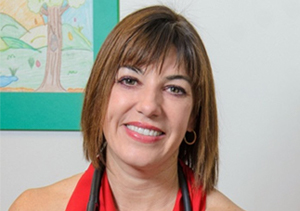
Brandy Wicklow is a Pediatric Endocrinologist at the Winnipeg Children’s Hospital, Associate Professor at the University of Manitoba, and Clinician Scientist at the Children’s Hospital Research Institute of Manitoba. Her research is focused on the determinants of type 2 diabetes (T2D) in children, with a particular interest in the Indigenous population of Northern Manitoba, Canada, with whom she works closely in clinical care and research. Dr. Wicklow is the Nominated Principal Investigator for a CIHR Diabetes Mechanisms and Translational Solutions Team Grant. Her team aims to define the mechanisms by which exposure to T2D in utero and the G319S variant impact how the beta cells of the pancreas and the nephrons in the kidney develop and function, and to determine the role of epigenetic programming in transmitting risk from in utero T2D exposure to b cell and kidney dysfunction. Upon completion of this study, they hope to better understand how maternal diabetes exposure and the HNF1a gene variant impact the health of the pancreatic beta cells and the kidneys in the infants, to identify markers at birth that identify which children are at highest risk of developing T2D, and to inform the development of new treatments to prevent T2D and renal complications in exposed children. Further reading
|
Can the Microbiome Be the Answer to Treating Human Disease?Scientists are studying the dialogue between microbes and the gut 
The human intestine is a mysterious universe teeming with trillions of bacteria and other microbes. Scientists have long known that having a healthy community of microbes in our gut is important for health, but past efforts to use probiotics, or good bacteria, to treat diseases has shown mixed results. Now, Dr. Alain Stintzi and his team, in collaboration with Dr. Mack from the Children’s Hospital of Eastern Ontario and Dr. Figeys from the University of Ottawa, are conducting a clinical trial to test a new approach. Rather than give patients probiotics, the researchers are giving patients a customized fiber supplement that will act as a nutrient source for the beneficial microbes. The patients in the trial are children with inflammatory bowel disease, namely ulcerative colitis and Crohn’s disease. The fiber supplement they receive has been precisely customized to each patient’s intestinal microbiome, with the aim of shifting the composition of their microbial community and boosting its production of beneficial metabolites. Through this research, Dr. Stintzi will assess the microbiome’s role in disease and investigate the cause-and-effect relationship between intestinal microbes and inflammation. While the clinical trial is still a year away from yielding results, the hope is that it will lead to new therapeutic options for inflammatory bowel disease and improve the quality of life for Canadians. Related reading: |
HIV/AIDS Research as TransformationUnderstanding HIV not just as a disease, but as an impetus for social movements 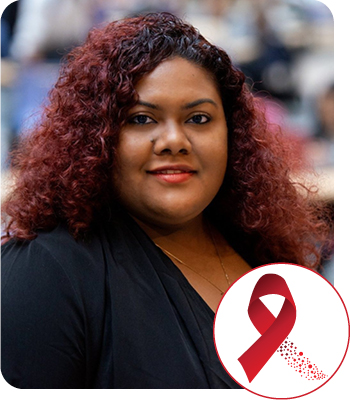
Dr. Ciann Wilson began her career as a human biology student at the University of Toronto, but an inspirational class taught by an instructor she respected on the sociology of HIV/AIDS changed everything. This class took a deep dive into the socio-structural factors that make communities more susceptible to disease, and it set a new trajectory for Dr. Wilson’s career. Today, Dr. Wilson works with queer, trans, and Black, Indigenous, and racialized communities. She approaches HIV from a social determinants of health lens, which examines the societal, economic, political, and environmental conditions that determine health outcomes. While much of health research remains descriptive and focuses on the level of individual behaviour, explains Dr. Wilson, there is a need to take a broader perspective to better understand why certain communities are left more vulnerable to chronic disease. She feels that health research can and must move beyond documenting and counting the deaths of intersectionally marginalized communities. To bring about transformative change in society, health research must include more nuanced socio-structural analysis — analysis that recognizes vulnerable communities to be resourceful survivors of systemic violence in the form of racism, colonialism, homophobia, transphobia, and classism — to name a few. Dr. Wilson is working to use her research to develop new sexual health programming, document the health experiences of Black, Indigenous and racialized communities, as well as challenge policies and push for shifts in health research training. She wants to see the needs of Black, Indigenous and racialized people addressed, with a strong belief that if we cater to the needs of the most intersectionally marginalized, we will bring everyone (i.e., in the broader Canadian population) with us in terms of improving our health. Related reading: |
Physics leads way to better kidney transplantationPostdoctoral researcher uses photoacoustics to develop new imaging tools for donor kidneys 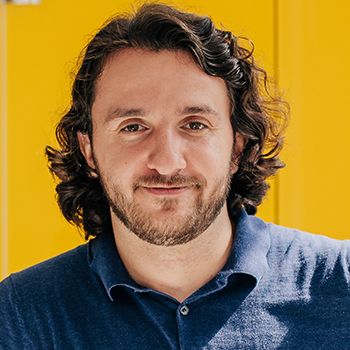
Kidney transplants provide a new lease on life for patients with chronic kidney disease, but not all donations are the same. The quality of the donated organ can affect the outcome of the surgery and how the kidney performs in the years following transplantation. Kidneys from sicker donors are usually accompanied by scarring, known as fibrosis, and have poorer outcomes than healthy kidneys. Also, the high demand for kidney transplants can force physicians to accept donations that are not optimal for transplantation. Dr. Eno Hysi, a Banting and KRESCENT Fellow at St. Michael’s Hospital in Toronto, one of the largest kidney transplant centres in Canada, is helping solve one of the most pressing problems facing nephrologists: the the inability to determine fibrosis present in kidney transplants. A physicist by training, Dr. Hysi is using his knowledge of how light and sound travel through biological tissue, or photoacoustics, to develop non-invasive imaging tools that allow transplant specialists to screen and select the most appropriate kidney by mapping the degree of fibrosis present at the time of surgery. This research is helping make better use of the scarce supply of donor organs and it may also help improve transplant outcomes for Canadians. For his outstanding work, Dr. Hysi was recognized with a 2021 Polanyi Prize in Physics. Related reading: |
Good Health for AllEnsuring that health care and community-based services are accessible for marginalized people in Canada 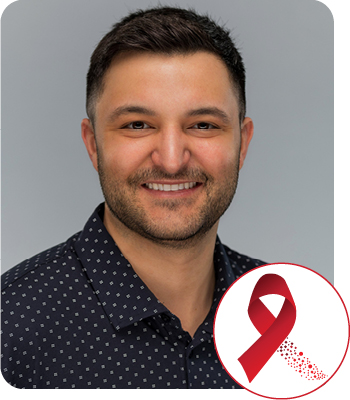
Infectious diseases such as HIV, Hepatitis C, and COVID-19 disproportionately affect marginalized people in Canada. For example, in 2019, the highest proportion of all reported adult cases of HIV/AIDS with known exposure were gay, bisexual and other men who have sex with men (39.7%), followed by cases attributed to heterosexual contact (28.3%), and among people who inject drugs (21.5%). To turn the tide on this disparity, Dr. Souleymanov has been working to make health care, community-based services, and social programs accessible to some of the most disenfranchised and marginalized communities in Canada. Over the past two years, Dr. Souleymanov was awarded more than $1.2 million through multiple grants from CIHR to lead his program of study. His research seeks to inform culturally sensitive models of health care and community-based services. One of his main focuses is the crucial social science of harm reduction and infectious disease. Drawing on his own lived experience, and the 12 years he spent as a community-based HIV and harm reduction researcher in Ontario and Manitoba, Dr. Souleymanov aims to not only prevent health and social disparities but also to promote wellbeing among key populations. His work through the Village Lab is further strengthening community-based research and improving health for key populations. |
Quality care for women with HIVEnsuring that women living with HIV aren’t excluded from infectious disease research 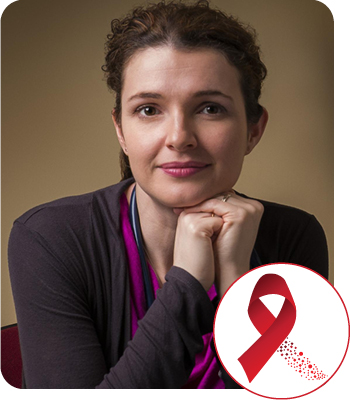
Women living with HIV constitute half of all people living with HIV worldwide but remain critically understudied compared to men living with HIV. This is where Melanie Murray’s research comes in. An infectious disease expert at the University of British Columbia, a Principle Investigator on B.C.’s CARMA:CHIWOS study, and a clinician at the Oak Tree Clinic, Dr. Murray cares for women living with HIV at all stages of their life, with an extra focus on hormonal dysregulation and comorbidities of aging. Dr. Murray involves HIV service organizations and women living with HIV in every step of her research, including as paid Peer Research Associates administering study questionnaires. Additionally, many of the questions she tackles in her research come directly from patients, so this is truly patient-oriented research. Dr. Murray says that the most rewarding aspects of her work are two-fold:
Through her practice, Dr. Murray is increasing our understanding of HIV and women, HIV and aging, and the structural and psychosocial determinants of women living with this illness. Related reading: |
When stress reaches a boiling pointResearcher is finding solutions to modern day crises 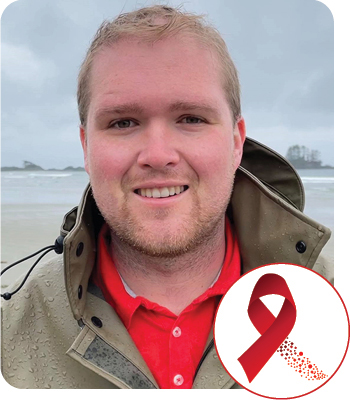
The concept of crisis is at the core of Dr. Kiffer Card’s research. The health services researcher from Simon Fraser University built his career studying the effects of stress on the individual and our institutions, when that stress becomes distress, and finally when mounting distress leads to a crisis—whether personal or societal. Stress is a normal part of life, but to Dr. Card, when the individual—or our institutions— are either unwilling or unable to relieve the stress, it turns into distress. His research looks at ways to alleviate stress and hopefully stop a situation from going into a full crisis. He began his public health career working in indoor environmental quality where he handled the concerns of university students who were in conflict with their landlords about the quality of their housing. Dr. Kiffer moved into HIV research when he began graduate studies and focused on substance use throughout his postdoc; now as an assistant professor he is working on climate change and loneliness, “the big picture crises of our day,” he says. As a social epidemiologist with a diverse set of research topics ranging from how we can use “social prescriptions” (e.g., time in nature) to provide more holistic primary care, to the mental health impacts of climate change and neoliberalism, Dr. Card examines the top crises of our day through a lens that includes both people and systems. Dr. Card was a recipient of the 2018 CIHR Health Systems Impact Fellowship and the 2020 CIHR-IHSPR Rising Star Award. |
HIV and the genital microbiomeDeveloping new ways to prevent sexual transmission of HIV 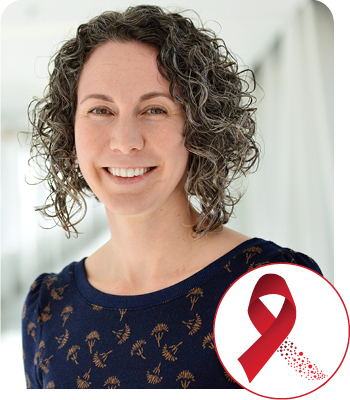
Since the first cases of HIV were reported more than 40 years ago, nearly 80 million people have become infected with HIV and 36 million have died from AIDS-related illnesses. Today, nearly 38 million people worldwide live with HIV and more than a million people are newly infected each year. While global efforts have helped reduce infections, increase access to treatment, and save lives, we desperately need new approaches to preventing infections. Dr. Jessica Prodger, an Assistant Professor at Western University, first witnessed the devastating impact of HIV while doing graduate work in Uganda in the mid-2000s. Medication to treat HIV only became widely available in Uganda in 2006, despite being available over a decade earlier in North America. This experience led Dr. Prodger to focus her research at Western on preventing sexual transmission of HIV and making an impact on the HIV epidemic in sub-Saharan Africa. Dr. Prodger is researching the role of the genital microbiome in HIV transmission. Unprotected heterosexual sex is one of the common sources of new infections. The foreskin of the penis is the main site of transmission in men and the bacteria that live under the foreskin are known to play a role in the susceptibility to infection. This is why male circumcision can significantly reduce HIV risk. It may also explain why some men who are exposed to HIV through unprotected sex with an HIV positive partner who is not on treatment are less likely to become infected. As part of her research program, Dr. Prodger is studying penile swabs and tissue samples from adult males in Uganda who have undergone voluntary circumcision to identify the bacteria and immune cells that may be responsible for facilitating and preventing HIV infection. Her work will help us better understand the interplay and communication between the penile microbiome and human tissue and how this relationship can influence the virus. The findings may help develop vaccines and microbicides for HIV prevention. Related reading: |
Improving health for Indigenous women living with HIVIndigenous researcher works alongside, and learns from, Indigenous women living with HIV 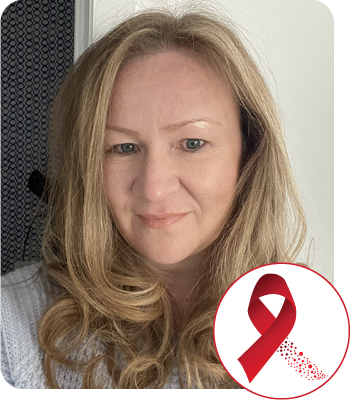
For the past 16 years, Carrie Martin, a Mi’gmaq woman, has worked with Indigenous women living with HIV and other sexually transmitted and blood borne infections. As a community-based researcher, her approach is grounded in Indigenous ways of knowing and doing and decolonizing methodologies. “It was blatantly apparent that health disparities existed and were perpetuated by a system wrought with discrimination and systemic racism that prevented Indigenous people from enjoying a quality of life similar to their Canadian counterparts,” Martin says of her early realizations when she first started working for the Native Women’s Shelter of Montreal at the age of 21. It’s been an uphill but rewarding battle for Martin. She launched a medical clinic housed at the Native Women’s Shelter, and in 2008 co-founded the Indigenous Health Centre of Tio’tia:ke. Currently, Martin is the recipient of a $3,469,000 CIHR grant to lead a project entitled Measuring Sexual and Reproductive Health and Rights (SRHR): Responding to the Needs of Indigenous Women and Girls in a Global Context, which will take place in seven countries over five years. This project will improve data collection, use and sharing, and increase partnerships to inform SRHR’s care programming. Martin’s work strives to be inclusive of all Indigenous cis- and trans-women, genderqueer and femme-identifying folks. Her dedicated work, now largely with Communities, Alliances & Networks (CAAN) and with the financial support of CIHR, seeks to create a more equitable world for women living with sexually transmitted and blood borne infections. Related reading: |
Measuring Indigenous homelessness and addictions in urban settings using Indigenous conceptual frameworks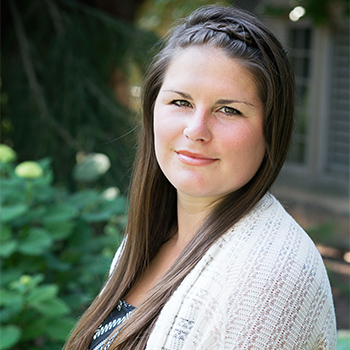
University of Toronto Stephanie McConkey is a First Nations/mixed European settler doctoral student in the department of Epidemiology at the University of Toronto whose research is currently focused on measuring Indigenous homelessness and addictions in urban contexts. Using the 12 dimensions of homelessness as defined by Jesse Thistle (2017) as a base, McConkey is working to formulate an indicator which can be used to specifically measure Indigenous homelessness and the multitude of factors that contribute to it as well as its impact on substance use among Indigenous peoples living in urban and related homelands. Given that Thistle’s current indicator of homelessness is applicable to Indigenous and non-Indigenous communities alike, it doesn’t capture the full experience and needs of Indigenous Peoples and the unique factors that contribute to Indigenous homelessness. Stephanie McConkey is dedicated to developing a model which considers the social, colonial, and structural factors which influence Indigenous homelessness. McConkey is taking an Indigenous-partnered approach, where community partners will co-lead the research, including the development of the research question and objectives, design and analysis plan, interpretation of findings, and all knowledge translation activities. With family members who have experienced homelessness or addictions in their lifetime, McConkey is driven to pursue this area of research and to deepen the understandings of Indigenous homelessness. She is particularly passionate about focusing on using Indigenous theoretical conceptual frameworks to develop statistical models, therefore shifting the common deficit-based data to instead develop statistics which celebrate Indigenous resilience. McConkey aspires this research will help close the gap of social division and inequity endured by Indigenous Peoples experiencing homelessness in urban contexts. Related reading: |
An ally for women with HIVAchieving better health outcomes and health equity for all women living with HIV 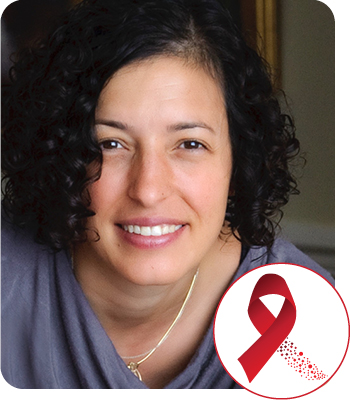
When the first cases of HIV were reported in the early 80s, the disease was initially thought to only affect gay men. More than forty years later, we know that the HIV epidemic has affected all genders, with women representing over half of the nearly 38 million people living with HIV in the world today. In Canada, women represented one in four of the more than 62,000 people estimated to be living with HIV in 2018 and this proportion is believed to be increasing. While antiretroviral therapy has changed HIV from a fatal disease to a chronic condition, people living with HIV continue to face challenges in accessing treatment and high-quality care. They also continue to face significant HIV-related stigma and discrimination. The effects of stigma are disproportionately felt by women – particularly women from racialized, Indigenous, and gender diverse communities. For more than 30 years, Dr. Mona Loutfy has been an advocate for women living with or affected by HIV. While pursuing her training as a physician at the Wellesley Hospital in Toronto in the 90s, Dr. Loutfy observed the devastating effects of HIV on her patients and the social factors that influence who becomes infected, the care they receive, and their health outcomes. This experience instilled a commitment to health equity and social justice which has only become stronger throughout her work over the past three decades as a clinician scientist. In 2006, Dr. Loutfy founded the Women and HIV Research Program, which uses community-based research and works in partnership with women living with HIV to carry out critical research to optimize the lives and care of women with HIV and their families. In partnership with community leaders, Dr. Loutfy and her team have made important contributions in the area of reproductive health and HIV and made a significant difference in the lives of Black, Indigenous, and trans women living with HIV. Dr. Loutfy led national pregnancy planning guidelines that have enabled people living with HIV to realize their dreams of having children and parenting while preventing transmission of the virus to their babies or sexual partners. She also led the Canadian HIV Women’s Sexual and Reproductive Health Study, a community-based research longitudinal study dedicated to creating knowledge to elevate the health and well-being of women living with HIV in Canada. In 2022, Dr. Loutfy was recognized with the highest honour in HIV research in Canada, delivering the Canadian Association of HIV Research (CAHR) Mark Wainberg Keynote Lecture. She has also received a CAHR-CANFAR (Canadian Foundation for AIDS Research) Excellence in Research Award and the University of Toronto Department of Medicine’s Michael Gordon Award for Humanism in Medicine. |
Understanding the health and social care needs of aging Indigenous adults

Dr. Sharlene Webkamigad is a registered nurse currently working on her Interdisciplinary Ph. D. in the Northern and Rural Health program at Laurentian University. Dr. Webkamigad has dedicated her research to improving the healthcare of aging Indigenous populations, who experience higher rates of chronic conditions than others, and who also have a strong preference to age and die in their own homes. She is focused on determining what the health and social care needs are for Indigenous older adults living outside of long-term care settings and their caregivers to develop a model and policies which address these needs, preferences, and priorities. Currently, Dr. Webkamigad’s research is focused within First Nations communities in the Anishinabek Nation. Taking an Indigenous community-based participatory approach, Dr. Webkamigad is seeking to identify the perceptions of Anishinabek older adults and their caregivers concerning the impact of community-level supports during the COVID-19 pandemic. Following consultation with the Health and Community Wellness Director and approval from the Chief and Council of Atikameksheng Anishinawbek, a group composed of health care providers, community leaders and Elders have been essential in supporting this research. This collaboration has helped develop local palliative care programs, frameworks for services that demonstrate cultural safety, and the self-determination of tribal councils, among others. As the granddaughter of a residential school survivor, Dr. Webkamigad has personally witnessed the challenges First Nations older adults and their caregivers face in the management of their health and wellness. Through hearing other residential school survivors’ stories, she is inspired to continue to identify the historical and colonial influences that have impacted the health of aging Indigenous adults, and work towards an improved healthcare system. Related reading: |
Exploring the health benefits of Métis danceTaking a holistic approach to exploring how culture and social support are connected to heart and stroke health 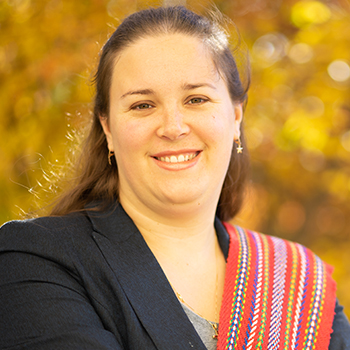
Assistant Professor, University of Saskatchewan Dr. Heather Foulds is an assistant professor at the University of Saskatchewan whose current work is dedicated to the health and wellness of the Métis community. Taking a holistic approach, Dr. Heather Foulds is exploring how culture and social support are connected to heart and stroke health, as well as discovering how Métis dance is an important factor in health as both a physical activity and a cultural expression. As a Métis woman herself, Dr. Foulds possesses a particular interest in this area of research given the sense of identity and the cultural connection that studying this area provides. Having participated in a Métis dance group for five years now, Dr. Foulds has been assisted in this research through the relationships she has formed due to her involvement, and by other Indigenous community members and advisors. As a result, Dr. Foulds has also been able to focus on the cultural and social significance that becoming reconnected to Métis dancing holds for the Indigenous community, such as its history, symbolism, and stories. Moving forward, Dr. Foulds aspires to share this practice more widely, and she encourages participation in this dance for those outside of the Métis community. Through analyzing a combination of factors, such as the experiences of new dancers and data such as oxygen consumption, Dr. Foulds can assess the physical intensity of the dance and explore the associated physical health benefits that come with it. Not only this but it also provides an opportunity for individuals to be reflective of Canada’s colonial history and enable preservation of knowledge for the Indigenous community. This component of her research complements the more qualitative data from this project that focuses on the physical improvement of cardiovascular health that this practice provides. Related reading: |
Becoming a scientific superhero!Resources for pediatric research made by kids 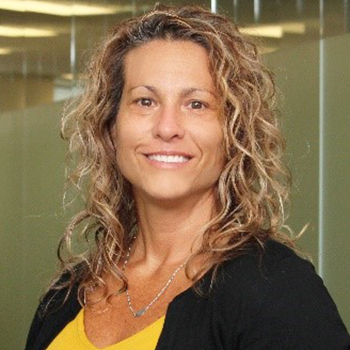
The Network of Networks (N2) is an alliance of Canadian research networks and organizations working to enhance national clinical research capability and capacity. Bringing together trialists and clinical research professionals from across the country, N2 provides a common platform for sharing best practices, resources, and research-related content to ensure efficient and high-quality research, integrity of clinical practices and accountability. As Chair of the N2 Clinical Trials Education and Awareness Committee, Daniela Bianco leads and works with a multidisciplinary team to develop educational and awareness resources/tools that aim to increase public knowledge and understanding of clinical research. The Committee recently produced a fun video as the first part of a toolkit to engage kids and their families and help them learn about research and clinical trials. The video is designed to encourage kids to become “participators” by registering for clinical research studies. It features a real-life participator and three-time cancer survivor who talks about his participation in clinical trials and why research is so important. The Committee’s video “The Participators” received a special commendation in the 2021 IHDCYH Talks video competition. Visit the IHDCYH Talks YouTube channel to watch all the submissions to the 2021 IHDCYH Talks video competition and more. Learn more about the annual IHDCYH Talks video competition. |
Teens Talk VapingIt’s time to centre teens in research about teen vaping 
The Human Environments Analysis Laboratory (HEAL) at Western University specializes in the production, evaluation, synthesis, dissemination, and mobilization of evidence to support effective policies, programs and professional practice aimed at creating healthy and vibrant communities. Teens Talk Vaping is a “by-youth-for-youth” research project, led by Dr. Jason Gilliland (HEAL Director and Professor at Western) and Dr. Stephanie Coen (Associate Professor at the University of Nottingham, Adjunct Research Professor at Western, and HEAL Faculty Associate), which seeks to understand teen perspectives on vaping. The goal is to better understand teens’ experiences and ideas about vaping, as well as how vaping features into their everyday lives. As part of the project, teen co-researchers and members of the HEAL Youth Advisory Council, produced a video sharing key themes regarding vaping that came out of focus groups involving project participants aged 13-19. The video takes a first-person point of view and follows the day-in-the-life motions of a fictional high schooler, which includes exposure to vaping in the school’s washrooms, party culture on the weekend where vaping is quite prevalent, and social media visits where vaping is pervasive. It captures some of the tensions that teens face when vaping opportunities and decisions surround them daily. HEAL’s video “Teens Talk Vaping” received a special commendation in the 2021 IHDCYH Talks video competition. Visit the IHDCYH Talks YouTube channel to watch all the submissions to the 2021 IHDCYH Talks video competition and more. Learn more about the annual IHDCYH Talks video competition. |
Promoting resilience in youth who have been victims of interpersonal violencePutting in place effective measures for prevention and intervention 
The work of Dr. Hébert and the members of her research laboratory at Université du Québec à Montréal focuses on childhood sexual assault and violence in youth relationships. Her research seeks to identify protective factors that can influence individual, family, social and community approaches to reduce the impact of victimization. She also works on projects carried out in close partnership with practice settings to promote the implementation of effective interventions to support optimal youth development and on research to help assess prevention programs intended to curb violence. Despite the troubling prevalence of sexual assault against youths, it is vital to convey a message of hope for victims, the adults in their lives and workers in the field—a message grounded in research that focuses on the factors that can promote resilience in these vulnerable populations. Dr. Hebert’s video “Agressions sexuelles envers les enfants” won third prize in the 2021 IHDCYH Talks video competition. Visit the IHDCYH Talks YouTube channel to watch all the submissions to the 2021 IHDCYH Talks video competition and more. Learn more about the annual IHDCYH Talks video competition. |
Fears of emergency department visits during the COVID-19 pandemicDon’t let them prevent you from taking your sick child to the hospital 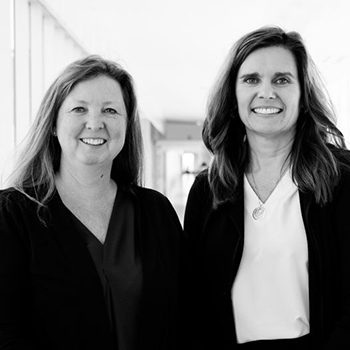
The COVID-19 outbreak has had a significant impact on how health information is communicated, how individuals seek health information and services, and how these services are delivered. There have been dramatic reductions in the number of children and families who have sought healthcare in emergency departments (ED) at hospitals. Dr. Shannon Scott and Dr. Lisa Hartling at the University of Alberta are developing and evaluating resources to help families understand essential health information and know when to use healthcare services during the pandemic. They have shown that by engaging parents as partners in health we can help them make decisions, shape treatment expectations for their children, and promote the effective use of health services. Dr. Scott and Dr. Hartling’s video “What to expect when visiting the ED during the COVID-19 Pandemic” received a special commendation in the 2021 IHDCYH Talks video competition. Visit the IHDCYH Talks YouTube channel to watch all the submissions to the 2021 IHDCYH Talks video competition and more. Learn more about the annual IHDCYH Talks video competition. |
Getting young Canadians active againThroughout the COVID-19 pandemic, Canadian children were less active and more sedentary 
Healthy development is fostered through ample physical activity, low sedentary behaviour, and adequate sleep. Doctors suggest that children and youth engage in at least 60 minutes of moderate-to-vigorous physical activity daily, reduce screen time to no more than 2 hours per day, and get at least 8 to 11 hours of restful sleep nightly to optimize physical and mental health. It was anticipated that the COVID-19 pandemic and the related public health restrictions would change the way children and youth engaged in play and healthy movement behaviours. It was no surprise, then, that Dr. Sarah Moore, an Assistant Professor in the School of Health and Human Performance at Dalhousie University and her colleagues at the Health Populations Institute found that children and youth were less active and more sedentary during the pandemic. Dr. Moore and her colleagues analysed data from two national surveys, with one focused specifically on Canadian children and youth with disabilities. The surveys collected information on the health behaviours of children and youth, including physical activity, outdoor play, sedentary behaviour, screen time, and sleep over the course of the COVID-19 pandemic. Parents reported that the pandemic not only affected the movement behaviours of their children, it also had a negative effect on their mental and physical health. Dr. Moore’s video “Canadian children and youth’s movement and play during the pandemic” received a special commendation in the 2021 IHDCYH Talks video competition. Visit the IHDCYH Talks YouTube channel to watch all the submissions to the 2021 IHDCYH Talks video competition and more. Learn more about the annual IHDCYH Talks video competition. Related reading:
|
Understanding compassionConsidering what a person wants rather than expressing an interest for being in their shoes 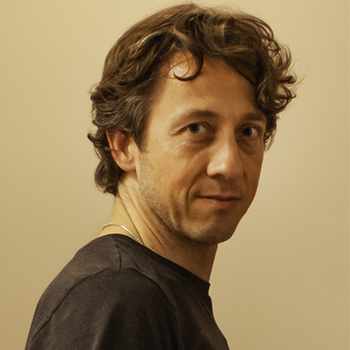
Ever wonder what makes compassion--compassion? How is it different than empathy, sympathy, kindness, caring? What needs to be present for compassion to occur? What are the key ingredients? The Compassion Research Lab at the University of Calgary has developed the Pediatric Model of Compassion based on the perspectives of pediatric patients, parents, and their healthcare providers across Canada. This model includes several components including one known as “seeking to understand” which is often the forgotten ingredient in compassionate care. Whether it be our desire to move from understanding to fixing. Our assumptions that we already understand or better understand what a person actually needs. Or our blind acceptance of the widely held misconception that compassion is understanding what it would be like for us to be in another person's shoes. Without an understanding of both the person and how they optimally experience compassion, we are left tripping over someone else's shoelaces – rolling our ankles and ruining their sneakers in the process – leading to misunderstanding and mistargeted kindness as a result. The Compassion Research Lab video “What is Compassion? The Defining Features and Power of Compassion” won second place in the 2021 IHDCYH Talks video competition. Visit the IHDCYH Talks YouTube channel to watch all the submissions to the 2021 IHDCYH Talks video competition and more. Learn more about the annual IHDCYH Talks video competition. |
How does breastfeeding affect a child’s health and development?3,500 Canadian kids and their families are helping scientists find answers 
Headquartered at McMaster University, and with recruitment sites at The University of British Columbia, University of Alberta, University of Manitoba, and the Hospital for Sick Children, the CHILD Cohort Study involves nearly 3,500 Canadian kids and their families across the country. By following the lives of the babies and their parents over many years, CHILD researchers have made exciting discoveries about how genetic and environmental factors influence childhood asthma, allergies, obesity, and other chronic diseases. One of these factors is breastfeeding, which benefits babies in many ways. CHILD research has demonstrated that babies who have been breastfed develop a high level of beneficial gut bacteria that promotes healthier growth patterns, lowers wheezing, and helps them avoid getting asthma when they get older. CHILD research has also discovered that how a baby is breastfed matters too – meaning there is a difference between feeding directly from the breast and feeding pumped breastmilk from a bottle, though even a little bit of breastfeeding is beneficial. The CHILD Cohort Study video “New scientific insights into breastfeeding” won first place in the 2021 IHDCYH Talks video competition. Visit the IHDCYH Talks YouTube channel to watch all the submissions to the 2021 IHDCYH Talks video competition and more. Learn more about the annual IHDCYH Talks video competition. Related reading: |
Breathe naturallyResearcher aims to improve sleep during the use of mechanical ventilators for ICU patients 
When patients are sick enough to be in an intensive care unit at a hospital, they may need a mechanical ventilator to help them breathe. While these machines provide ventilation to improve oxygenation, they may also cause significant discomfort for a patient and potentially serious lung damage. In an ideal state, a mechanical ventilator works in concert with a patient's respiratory system to produce smooth cycles of inhalation and exhalation. An asynchrony, or a mismatch between a patient's breathing demands and what is being supplied by the ventilator, can result in abnormal breathing patterns and make it difficult for patients to sleep. With the support of a CIHR Fellowship, Dr. Telias is studying a type of asynchrony called "reverse triggering" in which a mechanical inhalation triggers a second, natural inhalation from the patient, essentially a double breath in, which can increase the volume and pressure of air in the lungs to a harmful level. She has developed an algorithm for a mechanical ventilator that detects normal and abnormal breathing patterns in patients. Dr. Telias is also collecting data from patients on their sleep state (from fully awake to deep asleep) using a new automated sleep depth scoring system called Odds Ratio Product, which allows her to examine the relationship between asynchrony, sleep state, and sedation. |
Sleeping on itUnderstanding how nightly rest allows us to learn new cognitive skills 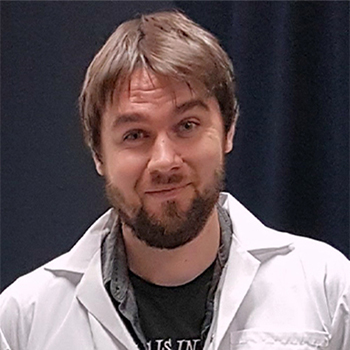
All humans require sleep daily to be physically and mentally healthy. Sleep is known to play a role in solidifying new memories and learning. However, researchers do not fully understand the processes in the brain that underlie the consolidation of newly acquired information and skills during sleep. With the support of a CIHR Fellowship, Dr. Dylan Smith from University of Ottawa Institute for Mental Health Research is combining electroencephalography (EEG) with functional magnetic resonance imaging (fMRI) to peer inside the brains of healthy volunteers and study these processes at work. Study participants are placed inside an MRI brain scanner wherein they are instructed to solve a visual puzzle before falling asleep. Dr. Smith is analyzing the data from these brain scans with a focus on sleep spindles – fast bursts of brain activity linked to sleep and memory – in parts of the brain associated with learning, such as the prefrontal cortex, hippocampus, and striatum. This research is providing new insight into how our brains integrate new learning while we’re sleeping. |
Keep on breathingHow targeting respiratory related neurons could help prevent life-threatening side effects of opioids on respiration 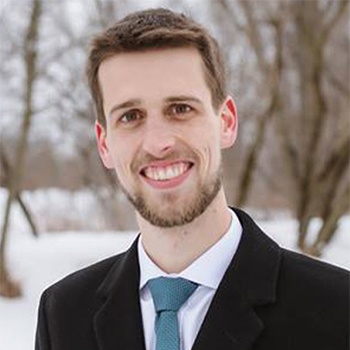
Opioid medication may relieve pain and improve sleep — but it is also addictive and opioid overdose has caused the death of thousands of Canadians in recent years. Pain relief from opioids occurs when the medication binds to specific receptors in the cells of parts of the brain that regulate breathing. During an overdose, a person's breathing becomes slower and shallower, potentially leading to respiratory failure and death. There is currently no way to prevent this respiratory depression from happening without affecting the pain-relieving properties of opioids. With the support of a CIHR Fellowship, Dr. Jean-Philippe Rousseau at Unity Health Toronto is studying the neurons located in part of the brain called the preBötzinger Complex. These nerve cells manufacture opioid receptors, as well as a small protein molecule called tachykinin precursor 1 peptide and the neurokinin-1 receptor, which together are believed to mediate respiratory depression caused by opioids. So far, Dr. Rousseau has discovered that stimulating these cells with a blue laser increases the respiratory rate and reverses respiratory depression in mice injected with opioids. |
Go to e-sleepImproving an online program for both infants and parents 
About 25% of families have sleep problems with their baby during the first year, which can affect the baby's development and behaviour as well as the health of the parents. With the support of a CIHR Fellowship, Dr. Elizabeth Keys from the University of British Columbia's Okanagan Campus was able to work with an interdisciplinary team at Dalhousie University to develop and test a mobile app that provides parents with infants aged 6 to 12 months access to evidence-based information, strategies, and resources that encourage sleep. The app was modified from the 'ABCs of Sleeping app for school-aged children', which Dr. Keys helped develop during her postdoctoral fellowship. As part her work, Dr. Keys reviewed studies of existing online and ehealth programs designed for parents to determine their strengths and weaknesses. Through her involvement in the 'Better Nights, Better Days' research program, she helped collect data from 85 Canadian families on how COVID-19 has affected the sleep patterns of the children in these families. This research has modified the online 'Better Nights, Better Days' pediatric sleep program so that its implementation among 1,000 Canadian families can be evaluated during the COVID-19 pandemic. |
Opioid use and osteoporosisProlonged use of these medications can impact bone structure 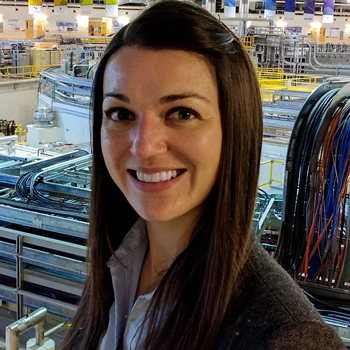
Misuse of opioids has led to a serious public health crisis. In only the first three months of 2020, 1,018 opioid-related deaths were recorded in Canada. Prolonged use of these medications can induce bone loss similar to osteoporosis and increase the risk of bone fractures. It’s critical for researchers to better understand the impacts of opioid use on bone metabolism, quality, and fragility. To achieve this goal, through use of high-resolution 3-D imaging, Dr. Andronowski and her research team are evaluating how opioids effect the internal structure of bones and their cellular organization. This will lead to potential treatments of opioid-induced bone loss. To carry out this research Dr. Andronowski is performing experiments at the Canadian Light Source, Canada’s national synchrotron facility. |
Making employment work for everyoneEvidence to develop public policies that improve the labour market for Canadians with disabilities 
According to the most recent Canadian Survey on Disabilities, more than one fifth of Canadians report living with at least one type of disability that affects their daily lives. In addition, nearly 650,000 Canadians who live with a disability are unemployed despite having the potential and desire to work. How do we better align the career goals ofpersons with disabilities with the needs of employers? Dr. Charles Bellemare is a professor and behavioural economist at Université Laval. As principal investigator of the Disability, Employment, and Public Policies Initiative, jointly funded by CIHR and SSHRC, he is examining how to improve the labour market for persons with disabilities so they can find satisfying jobs, pursue rewarding careers, and achieve financial security. The work of Dr. Bellemare and his team is producing new insights on how labour markets and public policies can help foster better integration of persons with disabilities in the Canadian economy. To inform their research, Dr. Bellemare and his colleagues are engaging persons with disabilities in ongoing discussion. They are hearing directly from them on the hurdles they face to finding employment and in other areas of their lives. In the end, they are not just helping create better public policy, they are helping make changes that will lead to more fulfilling lives for persons with disabilities in Canada. |
At the intersection of research and community safetyDeveloping safe street crossings and accessible public spaces 
Safe, equitable, year-round access to community spaces and infrastructure is a luxury not all Canadians have. The weather in Canada can create barriers and hazards for people who want to access outdoor facilities. The most challenging time is the harsh winter months when snow and icy conditions can make sidewalks and street intersections dangerous for pedestrians. It's even more challenging for persons with disabilities. Dr. Alison Novak is focused on understanding the role of pedestrian infrastructure, such as sidewalks, street crossings, and street furniture in developing livable and walkable neighbourhoods. Her research is producing evidence to inform recommendations to make homes and public spaces safer and more accessible. This includes offering much needed evidence on safety features for street crossings and how they can be designed to tolerate winter conditions and remain accessible to people with disabilities. The research done by Dr. Novak is helping create a safer built environment and promoting a higher standard for accessible communities. |
- Date modified:
